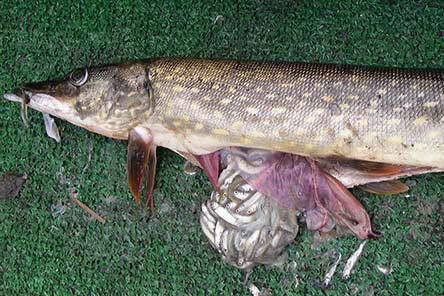Some anglers should expect to feel the impacts of the peninsula’s northern pike problem while fishing in 2022. That’s per two releases from the Alaska Department of Fish and Game describing restrictions connected to the treatment of invasive northern pike.
Retention of all fish species will be prohibited from East Mackey, West Mackey, Sevena, Union and Derks Lakes in 2022 to help restore native fish populations. Sport fishing will still be allowed, however, for catch-and-release fishing only, effective Jan. 1 through Dec. 31, 2022.
In announcing the advisory, ADF&G cited efforts to eliminate invasive northern pike in the lakes, such as the use of rotenone between 2014 and 2017. As part of that treatment plan, about 92,000 native fish were moved from Soldotna Creek to the lakes to help restore native fish populations.
Rotenone has historically been used for fish management and is effective at killing fish because it impacts the oxygen transfer needed for cellular respiration. The pesticide has shown to be successful at eliminating pike on the Kenai Peninsula, according to ADF&G.
“Continuation of these restrictions from 2018 through 2022 are needed to protect these native fish until they have established sustainable populations,” the department said in a release.
Similar restrictions have also been placed on fish caught in Stormy Lake, near Nikiski, in the new year because of northern pike treatments. Effective Jan. 1 through Dec. 31, 2022, the bag and possession limit of Arctic char/Dolly Varden is one fish less than 16 inches long. Fish longer than 16 inches must be released immediately.
Stormy Lake was also treated with rotenone as a way to eradicate northern pike in September 2012. ADF&G said that before being treated, eggs were taken from native Arctic char and reared in the William Jack Hernandez Sport Fishery, with fingerling released back into Stormy Lake the following summer.
Those char are now 9 years old and have reached maturity and spawning activity, according to ADF&G surveys. However, the species has a slow growth rate and low population densities, which the department said make the limited harvest opportunity “appropriate.”
Prohibiting anglers from keeping fish longer than 16 inches, the department said, will preserve about 90% of the mature fish while the population continues to be reestablished.
Pike are native to parts of Alaska north of the Alaska range, but were illegally introduced in Southcentral Alaska to Bulchitna Lake in the 1950s. That population grew rapidly after natural dispersion and further illegal introduction.
The first pike on the Kenai Peninsula are thought to have been introduced at Derks Lake in Soldotna where they were able to spread to other waters via drainage and additional illegal introductions, according to previous Clarion reporting. By the 2000s dozens of bodies of water on the Kenai Peninsula were infested with pike.
Pike cause problems because they are piscivorous, or fish-eating, according to the ADF&G.
“[In] nearly all water bodies where pike have been long established on the Kenai Peninsula, native fish populations have declined or have been completely eliminated,” Robert Massengill, of ADF&G, said during a public meeting earlier this year.
The Kenai National Wildlife Refuge and the ADF&G said earlier this year they would collaborate to eliminate the peninsula’s remaining pockets of invasive pike populations in the Miller Creek Watershed west of Hope.
More information about the 2022 restrictions can be found at adfg.alaska.gov.
Reach reporter Ashlyn O’Hara at ashlyn.ohara@peninsulaclarion.com.


